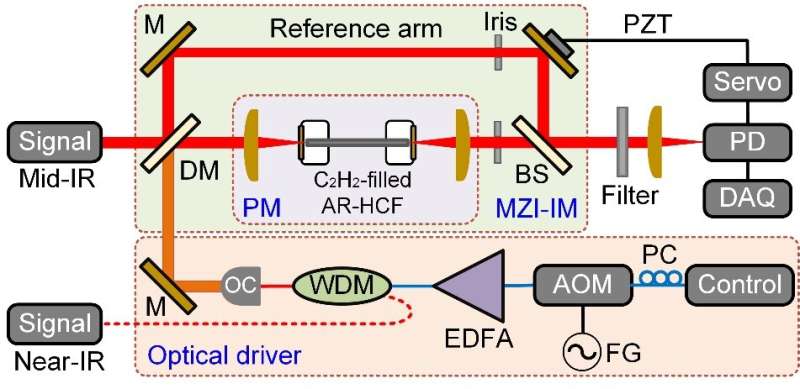Unique modulator could change mid-infrared photonic systems for the better

There has been significant interest in photonics over the last decade due to their prospects in creating functional devices both for near-infrared (NIR) and mid-infrared (MIR) wavelengths. Optical modulators are crucial photonic circuits that enable signal switching and routing, data encoding, phase-sensitive detection, and spectroscopic interrogation. For NIR modulators, various types of materials have spurred a large number of research projects.
In a new paper published in Light: Advanced Manufacturing, a team of scientists led by Professor Wei Jin from The Hong Kong Polytechnic University have developed a new MIR all-optical modulator based on an acetylene-filled hollow-core fiber.
The motivation for investigating modulator wavelengths further into MIR comes from the possible applications for photonics and sensing in this range. MIR modulators have a wealth of applications, including actively Q-switched laser generation, environmental pollution monitoring, chemical and biosensing, industrial processes control, multispectral thermal imaging, and medical diagnostics of early disease.
Most of the MIR modulators are established on waveguide-integrated or free-space platforms. On-chip integrated devices have attracted significant attention due to their flexible waveguide geometry and complementary metal oxide semiconductor compatibility.
Various waveguide-integrated modulators have been demonstrated, including those based on electrooptic, thermo-optic, free carrier plasma dispersion, and electro-absorption effects. Most waveguide-integrated modulators are based on the silicon-on-insulator or silicon-on-lithium-niobate platform, mainly used in the NIR region due to stronger material absorption at longer wavelengths.
For free-space modulators, metamaterial, hybrid and pattern structures are commonly used to enhance light-matter interaction to achieve higher modulation efficiency. Most MIR modulators are electrically driven with external electronics applied directly on the modulation devices.
The researchers have shown a novel method to achieve MIR phase modulation by exploiting the photo-thermal (PT) effect in acetylene (C2H2)-filled anti-resonant hollow-core fiber (AR-HCF). The PT effect in gas-filled HCFs has been exploited for ultra-sensitive gas detection.
The long interaction distance and near-perfect overlap of the HCF's pump and probe fields with gas material significantly enhance light-gas interaction, enabling larger phase modulation and hence better gas sensitivity over free-space systems. The researchers further extended the application scope of PT effect in the gas-filled HCFs to all-optical MIR modulators.
Different from the voltage-driven waveguide and free-space modulators, the PT MIR phase modulators are driven optically by a cost-effective control laser in the NIR telecom band. By placing the phase modulator (PM) in one arm of a Mach-Zehnder interferometer (MZI), MIR intensity modulation (IM) is further demonstrated. The AR-HCFs intrinsically have broadband transmission which, coupled with the narrow absorption lines of gas materials, makes it possible to develop ultra-broadband all-optical modulation devices from NIR to MIR.
More information: Kaiyuan Zheng et al, Mid-infrared all-optical modulators based on an acetylene-filled hollow-core fiber, Light: Advanced Manufacturing (2022). DOI: 10.37188/lam.2022.050
Provided by Chinese Academy of Sciences




















